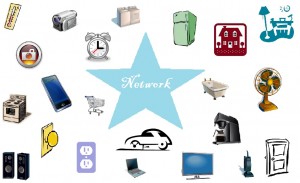Have you heard of this term yet? Comparatively to the internet, the Internet of Things (or IoT) is a new concept and it does not have a concrete definition yet. Proposed in 2009, the Internet of Things is composed of devices or objects that are uniquely identifiable and can interact with users/environment by connecting to internet like structures (Wikipedia, 2014). The internet currently consists of many devices and the majority connections are made using computers or servers. The Internet of Things examples include doors, refrigerators, televisions, air conditioners, alarm systems, cars, speakers and anything else you can imagine that can also be connected to the internet.
In business, we have seen and support IoT devices such as tracking systems, oil and gas monitoring and reacting equipment, water control and monitoring systems, new forms of manufacturing and monitoring processes, just to name a few.
Currently, these devices are being added to the Internet of Things but the speed at which this will happen in the not-so-distant future will increase very rapidly. There are many devices that we can connect to currently such as watching our TVs from anywhere in the world where there is an internet connection by using Slingbox or controlling the Sonos speakers in the office or home from your phone and transmitting music to them wirelessly and completely on demand. You can also install outlets, say in the business space, that turn lights on and off from your phone.
This is just the beginning! Imagine programming your refrigerator to notify you when you are getting low on milk or sending you a grocery list of items that you need to get? The possibilities are endless and this is why Samsung recently announced that they would like to lead in the production of IoT appliances and devices that are connected to the user. Control your whole house or business from your phone. Forgot to turn down the AC at the office before leaving? No problem, just take care of it from your phone.
While this is mostly beneficial to people there are a few things to think about. One very important factor is security. It is still a constant struggle to stay ahead of the game for antivirus providers and prevent breaches from evil hackers. Securing the Internet of Things has already proven to be a slight challenge. Even though there is not a whole lot of data available, the security firm Proofpoint are confident that a botnet that sends out spam has already attacked a magnitude of devices including IoT such as TVs and at least one refrigerator (Kassner, 2014 TechRepublic)! As comical as it may sound that somewhere out there, there is a fridge sending out spam, it is a very serious issue. No one wants a hacker controlling or breaking anything in their house or business place. Especially if you have the front door connected to the IoT and a thief can hack into your office or house. Currently, the best protection that Internet of Things has is being behind a solid firewall and not connecting devices that can cause a potential breach in security.







